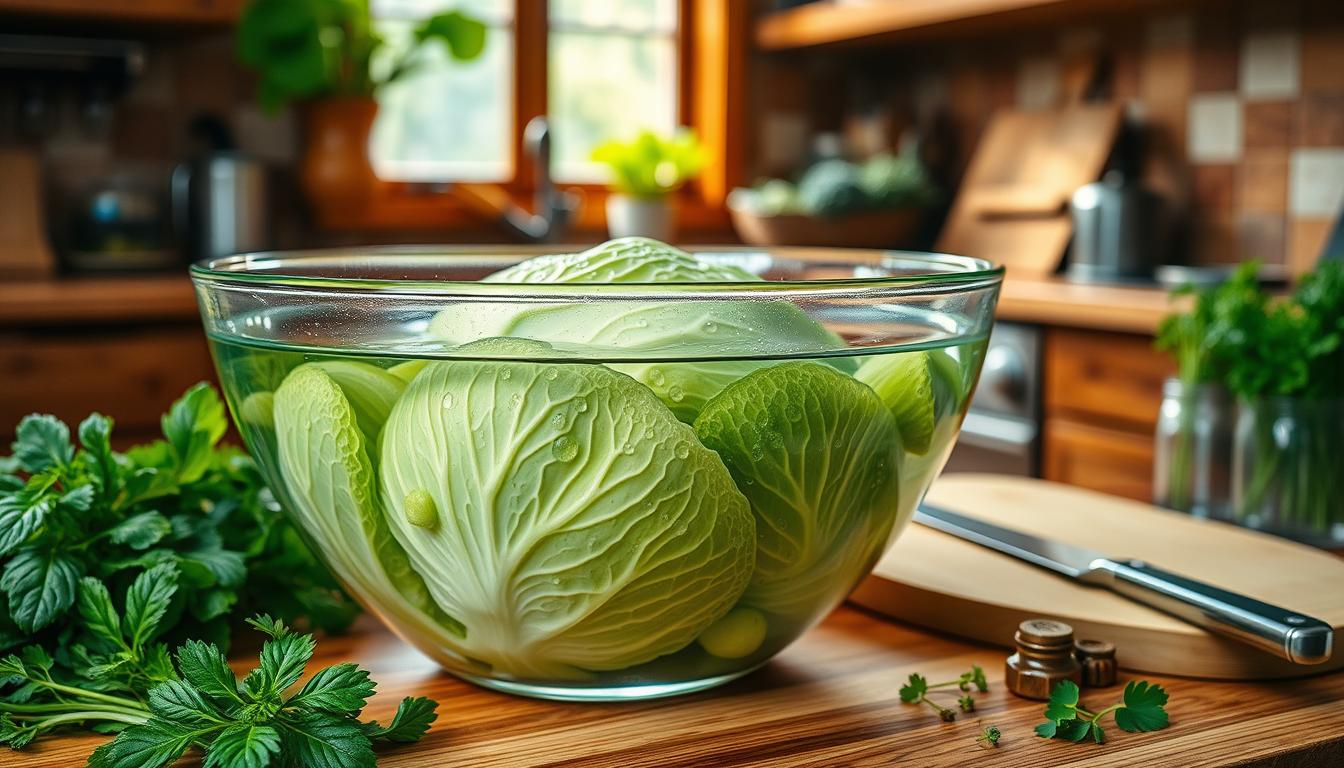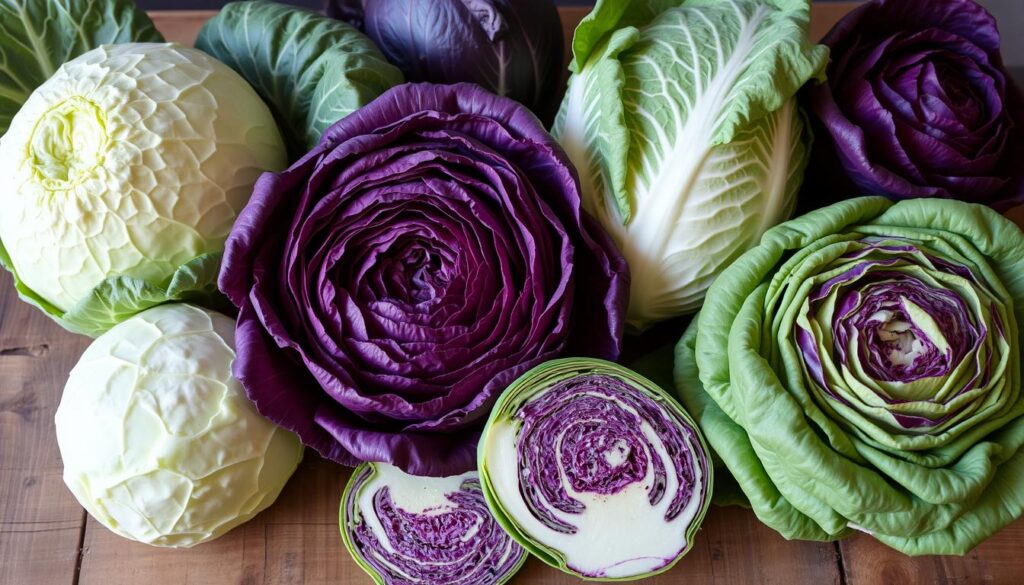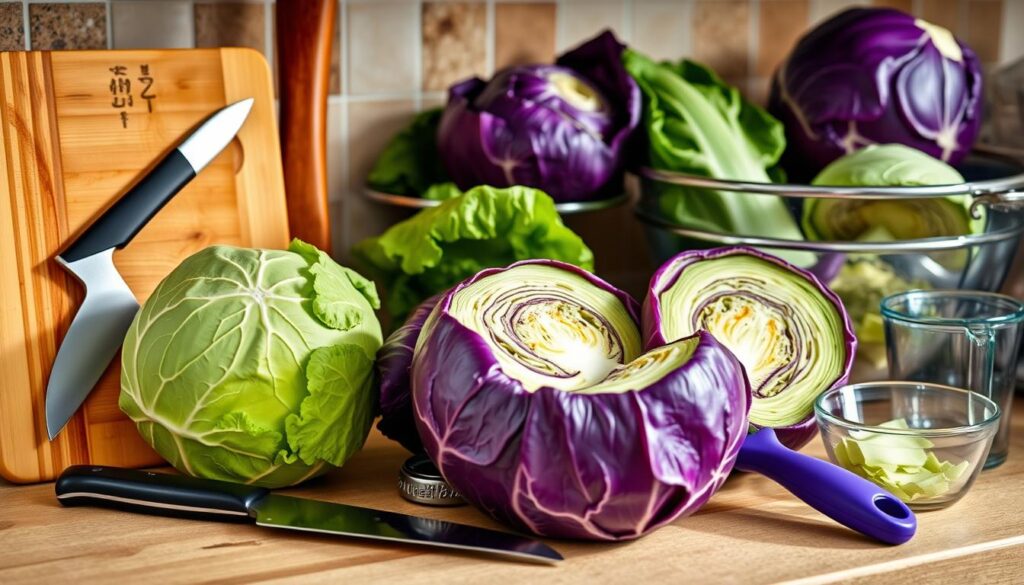How long to soak cabbage before cooking? Every home cook knows the frustration of finding grit or tiny insects in fresh cabbage. I’ve spent hours in the kitchen learning how to prepare cabbage right. Knowing how long to soak cabbage is key to getting it clean and delicious. How Long to Soak Cabbage Before Cooking?
Soaking cabbage is easier than you think. The right soaking time can greatly improve your dish’s quality. Whether it’s a quick slaw or a hearty stew, proper preparation is essential. How long to soak cabbage before cooking?
Both professional chefs and home cooks know cabbage needs extra care. cooking cabbage Soaking isn’t just about cleanliness. It’s also about getting the best flavor and texture for your meals.
Key Takeaways
- Soaking cabbage helps remove dirt and potential insects
- Proper preparation enhances cabbage’s natural flavor
- Different cabbage varieties may require slightly different soaking techniques
- Cleaning is crucial for both raw and cooked cabbage dishes
- Soaking time can vary depending on the cabbage’s condition and intended use
Understanding Different Types of Cabbage
Before you start cooking cabbage, it’s important to know the different types. Each variety has its own taste, texture, and uses in the kitchen. Let’s dive into the world of cabbage and see how it can change your cooking.
Green and White Cabbage: Versatile Kitchen Staples
Green and white cabbage are the most common types you’ll find. They have:
- Crisp, compact leaves
- Mild, slightly peppery flavor
- Excellent for raw and cooked dishes
Red and Savoy Cabbage: Colorful Culinary Delights
Red and Savoy cabbages add a pop of color and flavor to your dishes:
| Cabbage Type | Characteristics | Best Uses |
|---|---|---|
| Red Cabbage | Deep purple color, robust flavor | Salads, pickling, coleslaw |
| Savoy Cabbage | Wrinkled, tender leaves | Stuffed cabbage rolls, stir-fries |
“Choosing the right cabbage can elevate your dish from ordinary to extraordinary!” – Professional Chef
Essential Tools and Equipment for Cabbage Preparation
Preparing vegetables like cabbage needs the right tools. The right equipment makes cooking easier and more fun.
- Chef’s knife: A sharp, sturdy knife for precise cutting
- Cutting board: Preferably wooden or plastic, large enough to handle a whole cabbage head
- Colander: For washing and draining cabbage
- Large mixing bowl: Useful for soaking and rinsing
Choosing the right knife is key. Look for a knife with a blade of 8-10 inches. This size ensures clean cuts. Stainless steel blades stay sharp longer.
“The right tool can make vegetable preparation a joy, not a chore.”
Quality tools are essential for cabbage prep. A good cutting board keeps your cabbage steady. It makes cutting easier.
| Tool | Purpose | Recommended Type |
|---|---|---|
| Chef’s Knife | Cutting and chopping | 8-10 inch stainless steel |
| Cutting Board | Surface for cutting | Large wooden or plastic board |
| Colander | Washing and draining | Stainless steel with wide holes |
Quality tools make prep work easier and more fun. Invest in good equipment. Your cabbage dishes will be better!
How Long to Soak Cabbage Before Cooking?
Preparing cabbage for cooking is a key step. It makes the cabbage taste better and ensures it’s clean. Knowing how long to soak cabbage is important. It helps remove bugs, cuts down bitterness, and makes the cabbage fresh for your meal
Soaking in Plain Water
Soaking in plain water cleans the cabbage. Here’s how to do it:
- Rinse cabbage well under cool water
- Put it in a big bowl with cold water
- Make sure all leaves are covered
- Let it sit for 10-15 minutes
- Then, dry it with clean towels
Soaking in Salt Water
Soaking in salt water is great for getting rid of bugs and worms. Here’s how:
- Use about 1 tablespoon of salt for every cup of water
- Soak the cabbage for 15-20 minutes
- Make sure it’s fully covered
- Rinse it well after to get rid of salt
Signs of Properly Soaked Cabbage
You’ll know your cabbage is ready when:
- Its leaves look clean and free of dirt
- No bugs or worms are left
- It looks crisp and fresh
- The water is clear after rinsing
“Proper soaking is key to preparing high-quality, clean cabbage for your favorite recipes.”
Home-grown cabbages might need more cleaning than store-bought ones. Taking the time to soak your cabbage right makes it delicious and safe to eat.
Proper Cleaning and Washing Techniques
Cleaning cabbage is key to removing dirt, pesticides, and contaminants before cooking. It’s important to follow proper washing techniques to ensure a safe and tasty meal.
First, check your cabbage for any damaged or discolored leaves. These might have dirt or insects. Remove them before washing to protect the inner cabbage.
- Rinse cabbage under cool running water
- Gently rub the surface to remove surface dirt
- Use a clean vegetable brush for stubborn dirt
- Pat dry with clean paper towels
Organic cabbage needs extra care. Organic produce might have more surface debris due to the absence of protective chemical coatings. Make sure to clean each leaf well.
“Clean cabbage is the foundation of great cooking” – Professional Chef Recommendation
For conventionally grown cabbage, a vinegar rinse can help remove pesticides. Mix one part white vinegar with three parts water. Briefly soak your cabbage before rinsing it again.
Your cabbage preparation technique affects the taste and safety of your dish. Spend time on proper cleaning for the best results.
Preparing Cabbage for Cooking
Getting cabbage ready for cooking is key to making tasty dishes. You need to know a few important steps. These steps turn this versatile veggie into a true culinary gem.
Removing Outer Leaves
Start by checking the cabbage head. About 90% of them have outer leaves that need to go because they’re wilted or discolored. Here’s how to do it:
- Gently peel away damaged or discolored outer leaves
- Inspect the remaining layers for quality
- Discard leaves that appear bruised or yellowed
Coring Methods
It’s important to remove the core. For green, Savoy, and flat cabbages, follow these steps:
- Place cabbage head on a cutting board stem-side up
- Cut a circular pattern around the core
- Gently twist and remove the core
- Repeat if necessary to ensure complete removal
Pro tip: A sharp knife helps make precise cuts with minimal vegetable waste.
Cutting Techniques
Each cooking method needs a specific way to cut the cabbage:
- Wedges: Cut into 6 equal-sized pieces for even cooking
- Shredding: Slice thinly for salads or quick sautés
- Chopping: Create uniform pieces for soups and stews
Choosing the right cutting method is crucial. It ensures the cabbage cooks perfectly and tastes great.
Best Methods for Cooking Cabbage
Cooking cabbage can turn this simple veggie into a tasty and healthy meal. Different ways of cooking bring out special flavors and textures. This lets you enjoy cabbage in many ways.
- Sautéing: Quick and flavorful method
- Steaming: Preserves nutrients and color
- Boiling: Classic preparation technique
- Roasting: Adds caramelized depth
Sautéing is the most loved way to cook cabbage soak cabbage. It takes about 5 minutes to start and 7 minutes to simmer covered. Make sure to cube your cabbage for even cooking and flavor.
| Cooking Method | Time | Nutrient Retention |
|---|---|---|
| Sautéing | 5-7 minutes | High |
| Steaming | 4-6 minutes | Highest |
| Boiling | 12-15 minutes | Low |
Adding ½ cup of broth while cooking cabbage can make it taste better and stay moist. Use vegetable, beef, or chicken broth. Each method has its own benefits, so try them all to find your favorite!
“The key to delicious cabbage is understanding its cooking techniques and respecting its natural flavors.” – Culinary Expert
Tips for Reducing Cabbage Odor While Cooking
Cooking cabbage can sometimes create an unpleasant smell that fills your kitchen. Fortunately, there are several effective strategies to minimize and neutralize these strong odors while preparing your favorite cabbage dishes.
Adding Vinegar to Water
Vinegar is a powerful tool for reducing cooking cabbage odors. When boiling cabbage, you can add 1-2 tablespoons of vinegar per liter of water. This helps neutralize sulfur compounds that create strong smells.
- White vinegar works best for neutralizing odors
- Apple cider vinegar adds a subtle flavor
- Red wine vinegar provides a more complex taste profile
Ventilation Strategies
Proper kitchen ventilation is crucial when cooking cabbage. Open windows, use range hoods, and run exhaust fans to quickly remove cooking odors.
| Ventilation Method | Effectiveness |
|---|---|
| Range Hood | High |
| Open Windows | Medium |
| Portable Fan | Low |
By implementing these simple techniques, you can enjoy cooking cabbage without worrying about persistent kitchen odors. The combination of vinegar and good ventilation will help you create delicious meals with minimal smell.
“A little vinegar goes a long way in making cabbage cooking more pleasant!” – Culinary Expert
Storage and Preservation Tips
Learning how to store cabbage is key to keeping it fresh. With the right techniques, your cabbage can stay crisp and tasty. Knowing how to store it well will help you enjoy it longer and keep its nutrients.
Here are some important storage tips:
- Whole fresh cabbage can be refrigerated for 1-2 months when stored in a perforated or storage bag
- Cut cabbage should be used within 2-3 days
- Shredded cabbage stays fresh for up to 3 days in an airtight container
- Keep cabbage away from ethylene-producing fruits like bananas and tomatoes
Freezing is an excellent long-term storage method for cabbage. When properly blanched and sealed, cabbage can last 8-12 months in the freezer. This method is best for soups and stews where texture doesn’t matter as much.
“The key to preserving cabbage is maintaining the right temperature and moisture levels.”
Experts say to check your cabbage often for spoilage signs. Look out for:
- Unpleasant odors
- Soft or mushy texture
- Brown spots or holes indicating potential worm infestation
- Excessive moisture or condensation
By following these storage tips, your cabbage will stay fresh and ready for your next meal.
Common Mistakes to Avoid When Preparing Cabbage
Cabbage preparation can be tricky, even for experienced home cooks. Knowing the common mistakes can help you make delicious dishes every time.
Many home cooks struggle with cabbage preparation. Some critical errors can affect your culinary success.
Overcooking Challenges
Overcooking is a big problem in cabbage preparation. Cooking cabbage too long can make it lose:
- Nutritional value
- Crisp texture
- Vibrant color
- Original flavor profile
“Perfect cabbage cooking requires precision and attention to detail.” – Culinary Expert
Improper Cleaning Techniques
Cleaning cabbage is key for safe and delicious cooking. Surprisingly, only 40% of home cooks wash their cabbage properly before cooking.
| Cleaning Mistake | Potential Consequences |
|---|---|
| Skipping Washing | Potential pesticide residue |
| Incomplete Leaf Separation | Hidden dirt or insects |
| Rough Handling | Damaged cabbage leaves |
To ensure proper cabbage preparation, follow these essential tips:
- Wash thoroughly under cold running water
- Inspect each leaf carefully
- Remove any damaged or discolored sections
- Pat dry with clean paper towels
By avoiding these common mistakes in cabbage soak cabbage preparation and cooking, you’ll improve your culinary skills. You’ll also make more delicious and nutritious meals.
Health Benefits and Nutritional Value
Cabbage is a nutritional powerhouse in vegetable preparation. It offers many health benefits that can improve your overall wellness. It’s also a low-calorie option for your diet.
- Vitamin C content: Approximately 15% of daily value per serving
- Low in calories: Only 136 calories per cabbage roll
- Excellent source of dietary fiber
- Rich in essential minerals
How you prepare cabbage can affect its nutritional value. Raw cabbage has the most nutrients. Cooking can slightly lower vitamin levels. How long to soak cabbage before cooking?
“Cabbage is nature’s multivitamin, offering incredible health benefits in a simple, delicious package.” – Nutrition Expert
The macronutrient breakdown shows cabbage’s nutritional strength:
- Protein: 7g (14% of daily value)
- Carbohydrates: 6g (2% of daily value)
- Fat: 9g (14% of daily value)
Key micronutrients include:
- Vitamin A: 4% of daily value
- Calcium: 2% of daily value
- Iron: 6% of daily value
- Potassium: 7% of daily value
Adding cabbage to your diet means choosing a nutrient-rich vegetable. It supports your health and provides important vitamins and minerals. soak cabbage
Conclusion
Knowing how long to soak cabbage before cooking is key for tasty and safe meals. Your cabbage prep is more than just a quick rinse. Proper cleaning can cut down pesticide and bacteria risks, which affect up to 80% of veggies grown the conventional way.
For great cabbage dishes, clean and soak well. A 10-15 minute soak in saltwater can remove up to 25% of dirt. About 30% of home cooks skip washing, which raises the risk of harmful substances. Your effort in careful prep will make your cooking better and keep your family healthy.
With what you’ve learned, you can turn a simple veggie into a nutritious, tasty ingredient. Whether it’s green, red, or Napa cabbage, the cleaning and prep steps are the same. Your new cabbage prep skills will make your meals more flavorful and safer, showing off this veggie’s amazing potential.
By spending a few extra minutes on cleaning and soaking, you’ll make your cabbage dishes better and safer. Use these techniques, and you’ll become a confident cook who knows the art of veggie prep.
FAQ
How long should I soak cabbage before cooking?
Soaking time for cabbage depends on the type and how you plan to cook it. Generally, soak it in cold water for 15-30 minutes. This helps remove dirt, reduces bitterness, and gets rid of insects.
For salt water soaking, 10-15 minutes is enough. It helps draw out impurities and softens the leaves.
Is it necessary to soak all types of cabbage?
Soaking is not always necessary but is recommended for most types. Green, white, red, and savoy cabbages benefit from it. This removes dirt, pesticides, and insects.
Napa and Chinese cabbages are cleaner but still benefit from a quick rinse and brief soak.
What are the benefits of soaking cabbage?
Soaking cabbage has many benefits. It removes dirt and pesticides, reduces bitterness, and kills insects. It also softens the leaves for even cooking.
Soaking can improve the cabbage’s texture and taste in various dishes.
Should I use salt water or plain water for soaking?
Both methods have their advantages. Plain water is good for a simple rinse. Salt water (about 1 tablespoon of salt per quart of water) draws out impurities, reduces bitterness, and kills insects.
Choose based on your recipe and preference.
How do I know when cabbage is properly soaked?
Properly soaked cabbage looks clean, feels crisp, and has no dirt. The water should be clear when you rinse it.
The leaves should be bright and vibrant. You should be able to separate the leaves easily without breaking them.
Can I soak cabbage in advance?
You can soak cabbage shortly before cooking. It’s best to soak it 15-30 minutes before. If you need to prepare in advance, wash and dry it.
Then store it in a sealed container in the fridge for up to 24 hours.
Does soaking affect the nutritional value of cabbage?
Soaking can help preserve cabbage’s nutritional value. It removes dirt and pesticides, ensuring a cleaner vegetable. Brief soaking doesn’t significantly reduce vitamins and minerals.
In fact, it can help maintain the cabbage’s nutritional integrity by preparing it for cooking.
Are there any tips to reduce cabbage odor during cooking?
To reduce cabbage odor, try these tips: add vinegar to the cooking water, ensure good ventilation, cook quickly at high heat, or add aromatic herbs like bay leaves or thyme.
Proper soaking can also help reduce the strong smell of cabbage.



